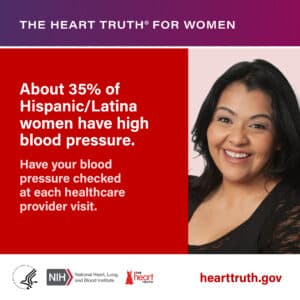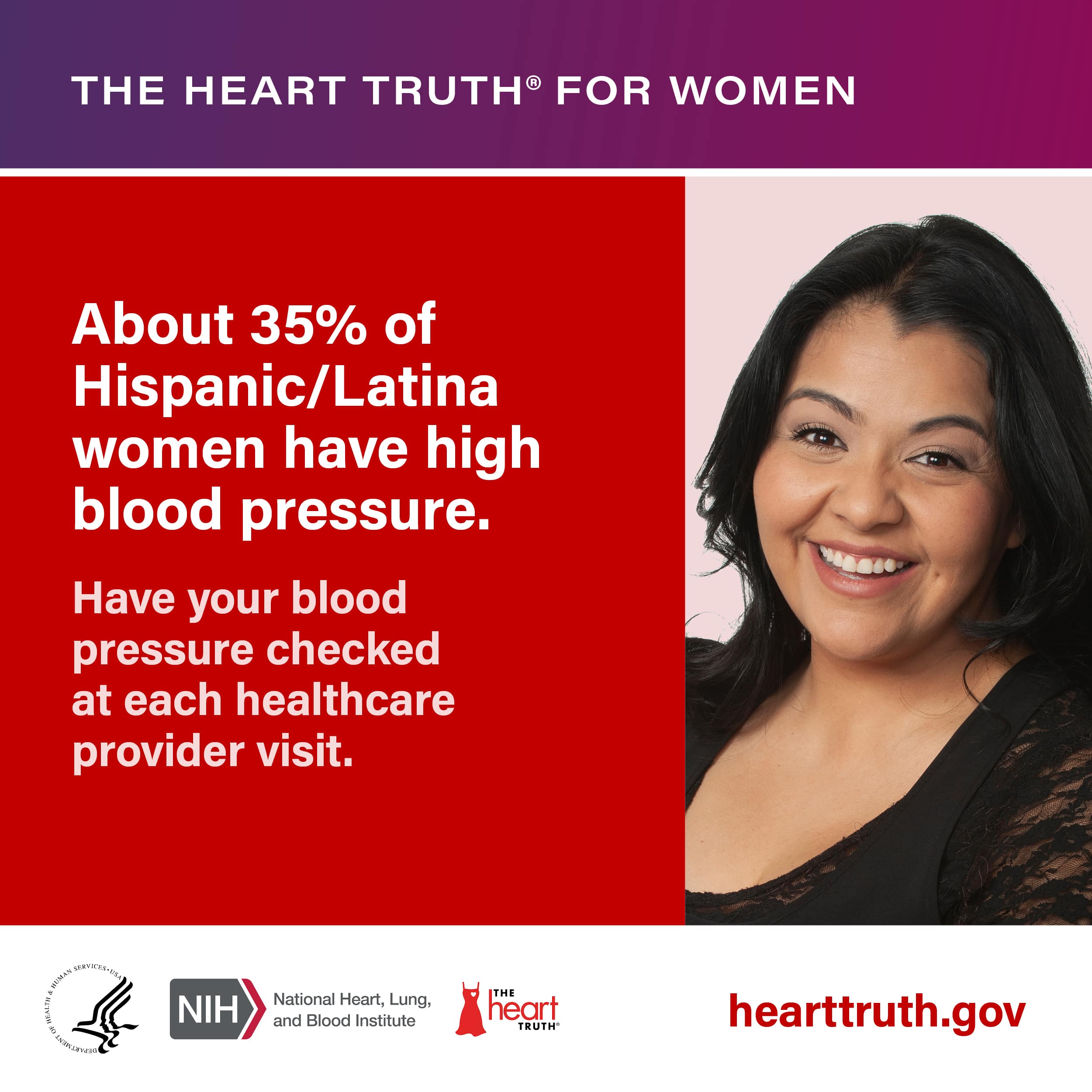Did you know heart disease is the leading cause of death in the United States but impacts some communities disproportionately? Health problems that increase the risk of heart disease are common in Hispanic/Latino communities, including high blood pressure, high cholesterol, and diabetes and being overweight. Having multiple risk factors increases the risk of heart disease. But the good news is that there’s a lot we can do to prevent it.

Did you know?
Hispanic/Latina women 20 years and older: 78% are overweight, 35% have high blood pressure, 34% have high cholesterol, and 12% have been diagnosed with diabetes.
Hispanic/Latino men 20 years and older: 87% are overweight, 50% have high blood pressure, 33% have high cholesterol, and 15% have been diagnosed with diabetes.
Connecting with Others is Good for Your Heart
People with close relationships at home, work, or in their community tend to be healthier and live longer. One reason, according to the National Heart, Lung, and Blood Institute (NHLBI), is that we’re more successful at meeting our health goals when we work on them with others. Feeling connected with others and having positive, close relationships benefit our overall health, including our blood pressure and weight. Having people in our lives who motivate and care for us helps, as do feelings of closeness and companionship.
Raise awareness about heart health in your community to help people better understand their risk factors and take actionable steps to prevent or reduce them.
Lifestyle Tips
Here are some facts, how–to tips, and resources to inspire you and your community to work together to live heart–healthy, even if you can’t be physically together, to improve your heart health.
- Be more physically active.
- Maintain a healthy weight.
- Eat a nutritious diet.
- Quit smoking.
- Manage stress.
- Get 7–9 hours of quality sleep.
- Track your blood pressure, cholesterol, and blood sugar numbers.
You don’t have to make big changes all at once. Small steps will get you where you want to go. Here are some ways to get started.
Move More
Invite family, friends, colleagues, or members of your community to join you in your efforts to be more physically active:
- Ask a colleague to walk “with you” regularly, put the date on both your calendars, and text or call to make sure you both get out for a walk.
- Get a friend or family member to sign up for the same online exercise class, such as a dance class. Make it a regular date!
- Grab your kids, put on music, and do jumping jacks, skip rope, or dance in your living room or yard.
How much is enough? Aim for at least 2½ hours of physical activity eachweek — that’s just 30 minutes a day, 5 days a week. In addition, do muscle–strengthening exercises 2 days a week. Can’t carve out a lot of time in your day? Try doing 10 minutes of physical activity three times a day. NHLBI’s Move More fact sheet has ideas to get and keep you moving.
Aim for a Healthy Weight
Find someone in your friend group, at work, or in your family who also wants to reach or maintain a healthy weight. (If you’re overweight, even a small weight loss of 5–10% helps your health.) Check in with them regularly to stay motivated. Agree to do healthy activities, like walking or cooking a healthy meal, at the same time, even if you can’t be together. Share low–calorie, low–sodium recipes. Check out NHLBI’s Are You at a Healthy Weight? fact sheet.
Eat Heart–Healthy
We tend to eat like our friends and family, so ask others close to you to join in your effort to eat healthier. Together, try the free Dietary Approaches to Stop Hypertension (DASH) eating plan. Research shows that, compared to a typical American diet, it lowers high blood pressure and improves cholesterol levels. Find delicious recipes at NHLBI’s Heart–Healthy Eating webpage.
Quit Smoking
To help you quit, ask others for support, or join an online support group. Research shows that people are much more likely to quit if their spouse, friend, or sibling does. Social support online can help you quit. All states have quit lines with trained counselors — call 1-800-QUIT-NOW (1-800-784-8669). You’ll find many free resources to help you quit, such as apps, a motivational text service, and a chat line at BeTobaccoFree.hhs.gov and Smokefree.gov.
If you need extra motivation to quit, consider those around you: Breathing other people’s smoke, called secondhand smoke, is dangerous. Many adult nonsmokers die of stroke, heart disease, and lung cancer caused by secondhand smoke.
Manage Stress
Managing stress helps your heart health. Set goals with a friend or family member to do a relaxing activity every day, like walking, yoga, or meditation, or participate in an online stress–management program together. Physical activity also helps reduce stress. Talk to a qualified mental health provider or someone else you trust.
Improve Sleep
Sleeping 7–9 hours a night helps to improve heart health. De–stressing will help you sleep, as does getting a 30–minute daily dose of sunlight. Take a walk instead of a late afternoon nap! Family members and friends: remind each other to turn off the screen and stick to a regular bedtime. Instead of looking at your phone or the TV before bed, relax by listening to music, reading, or taking a bath.
Track your Heart Health Numbers, Together
Keeping a log of your blood pressure, weight goals, physical activity, and, if you have diabetes, your blood sugar will help you stay on a heart–healthy track. Ask your friends or family to join you in the effort. Check out NHLBI’s My Heart Health Tracker. Visit www.hearttruth.gov for more information about heart health.


